| |
| |
The Blue Morpho beckoned me deeper along the seldom-traveled jungle path as I tried in vain to capture her iridescent splendor during brief touchdowns in the foliage-filtered sunlight. Preoccupied with my cerulean flutterby, I suddenly found myself face to face with an ornately carved structure, its massive monster-mouth doorway lined with formidable-appearing stone teeth. |
|
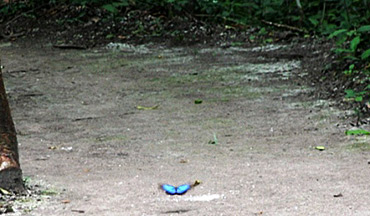 |
|
I’d long desired to explore Mexico’s Río Bec region, situated adjacent to the Guatemalan border and home to one of the major political powerhouses of the Classic Maya period, Calakmul (kah-lahk-MOOL). Extending across portions of the states of Quintana Roo and Campeche, much of it encompassed within the 1.8-million acre Calakmul Biosphere Reserve, the region is crowded with ancient cities. Around four dozen settlements have been identified thus far in the Biosphere Reserve alone.
Distinctive features such as monster-mouth doorways, open relief ornamentation covering buildings top to bottom, rounded corners, and solid masonry towers crowned by fake temples has bestowed the name Río Bec on an entire style of Maya architecture.
| |
Structure II at Chicanná epitomizes Río Bec-style architecture: A façade covered in carved images. A doorway appearing as an enormous open serpent mouth approached by stepping between huge up-curving teeth lining a platform that represents the lower jaw. Massive fangs overhanging the lintel to complete the gaping jaw appearance. |
|
I have probed six ancient Maya cities in the past two days, with two days, four sites and a State capital’s amazing museum still awaiting my exploration. (See Ancient Cities of the Río Bec http://highonadventure.com/hoa10oct/vicki/riobec.htm for my adventures during the first two days of my whirlwind trip). It’s a promising start to Day Three.
| |
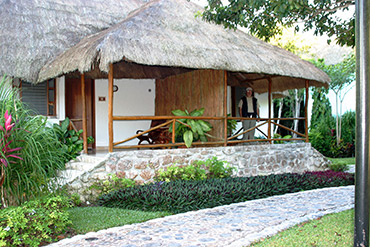 |
|
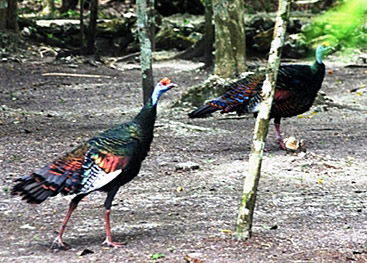 |
|
| |
Surrounded by thick tropical forest, the Chicanná Ecovillage Resort features 42 attractive and comfortable rooms, many placed in duplex bungalows.
|
|
Oscillated turkeys amble alongside the road to Chicanná. The Calakmul Biosphere Reserve is home to spider and howler monkeys, ocelots and pumas, wild hogs and tapirs, armadillos and deer. |
|
| |
|
|
| |
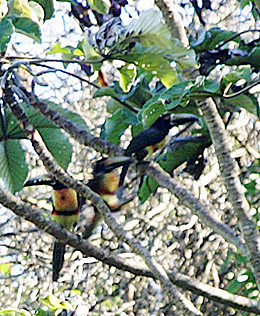 |
|
| |
A trio of toucans are among hundreds of tropical and migratory bird species inhabiting the region. |
|
Lulled to sleep by unidentified critters in the surrounding jungle, a medley of avian song greets the morning. Directly across Highway 186 from our lodgings at the Chicanná Ecovillage Resort, a dirt road continues about a half-mile to the site of Chicanná (chee-kah-NAH). The intimidating entrance to Structure II gave the site its Mayan name, Serpent-Mouth House: chi (mouth) + can (serpent) + na (house).
| |
Richly carved panels of open-jawed serpents (left) flank each side of the monster-mouth doorway on Structure II at Chicanná, its main façade covered with mosaic masks. Just to the right of the panels, hidden and protected for centuries by a layer of stucco which fell off in the 1980s, are remains of red painted glyphs (center). More traces of paint (right) indicate the structure was painted red with traces of black, white, blue, yellow and green. |
|
Occupied as far back as 300 BCE, Chicanná flourished during the 7th century and continued to be populated until the late 11th/early 12th century. I follow paths that weave through dense foliage among five groups of richly ornamented buildings in various states of excavation/consolidation/restoration, finding some in excellent condition.
| |
|
|
| |
To the west of Structure II, across the Main Plaza, Structure I may be Chicanna’s best example of Río Bec architecture. The main façade is covered with mosaic masks, and its two restored round-cornered end towers emulate the soaring pyramids of Tikal, El Mirador and other Petén cities of northern Guatemala: see Lords of the Petén, Guatemala http://www.highonadventure.com/Hoa06apr/Vicki/Peten.htm |
|
Chicanná was contemporary with and may have been a dependency of nearby Becán (beh-KAHN), who reigned as a major population center and is among the largest and most elaborate of Río Bec sites. Traces of human occupation at Becán date as early as 600 BCE, reaching its peak between 600-1000 CE, then slowly declining until the mid-15th century. It was a fortified, defensive city.
| |
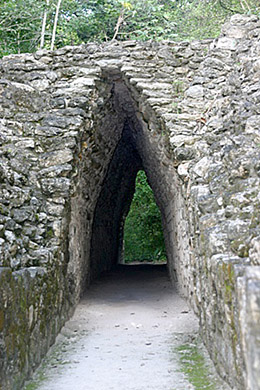 |
|
Visitors to Becán enter via the southeastern causeway and immediately encounter a vaulted passageway which served as a street, with nearly 220 feet of it covered with a corbelled arch and built-in niches for the deposit of offerings. |
| |
|
|
|
Built on the edge of a limestone outcrop as much as thirty feet higher than the surrounding countryside, Becán’s monumental structures are grouped around three large plazas covering 63 acres and surrounded by a 1.2-mile long moat. Actually an earthwork ditch, the moat’s embankment averages 48 feet wide and seven feet deep and is bridged by seven causeways into the city. Behind the moat are remains of a defensive wall rising over ten feet tall in places.
| |
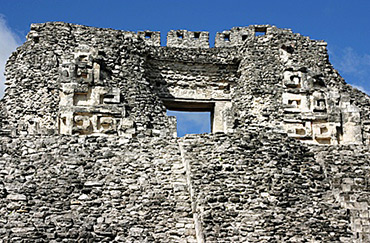 |
|
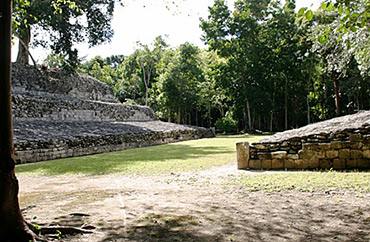 |
|
| |
Entombing an earlier building in the 7th century, Becán’s Structure X contained twelve rooms on two levels, but now only the remains of the lower part of its perforated roof comb hint at its former glory. |
|
Becán’s Ball Court, a.k.a. Structure XI, is unusual because ball courts are rarities at Río Bec sites.
|
|
| |
Archaeological excavation inside structures often reveals encapsulated temples adorned with carved and painted facades. On the backside of Becán’s Structure XIII, a Plexiglas window reveals an ancient treasure: a carved stucco façade of the Maya Descending God with traces of red pigment still discernible. |
|
South of Chicanná, the caretaker at Hormiguero (or-mi-GER-o) told a forlorn story: we were the first visitors in nearly a month. After a bit of a chat we headed down the path to this small site where 84 structures have been identified but less than a dozen excavated. Perhaps if more folks came here, INAH (Mexico’s Instituto Nacional de Antropología e Historia) might find it worthwhile to delve deeper into Hormiguero’s history.
| |
Suddenly materializing in a small jungle clearing is Hormiguero’s exceptionally ornate and well preserved Structure II, sections of its elaborate stucco work still in place. Twin towers and rounded corners are earmarks of Río Bec architecture, as well as the mask above the upper doorway with downward projecting teeth and profile serpent heads on either side of the door. |
|
Ten miles north of Chetumal and about a half-mile inland from the Bay, Oxtankah (osh-tahn-kah) is a medium-sized site with more than 40 structures scattered about an unspoiled forest. In sharp contrast to the beautifully styled and ornamented buildings of the Río Bec region, Oxtankah displays both Maya and European influence.
| |
Oxtankah was named for the abundance of Ramon trees (“ox” in Mayan). Strangler figs (left) and exotic flowers also thrive in the area. |
|
A coastal trading center that thrived between 600 and 200 BCE, the city was occupied for nearly a thousand years before being abandoned for nearly the same length of time. The Spaniards arrived during the 15th century and lasted just two years before the locals drove them out.
| |
Oxtankah contains numerous multi-tiered pyramidal platforms once topped with temples constructed of perishable material. Some of these platforms contained vaulted-ceiling tombs beneath the floors. |
|
| |
|
|
| |
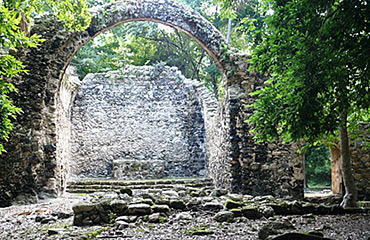 |
|
| |
This 16th century Spanish church sits atop of and was built from remnants of ancient Maya structures. This is believed to be the oldest church in the area. |
|
Back in Chetumal, capital of Quintana Roo and our starting point just three days ago, the adventures and discoveries of the last few days is hard to reconcile with this bustling port city of about 150,000 people. Immersed in the wonders of the Río Bec region, we were only 80 miles west of here, yet travelled more than 2,250 years back in time.
Located on Chetumal Bay adjacent to the northern border of Belize, this location was also important to the ancient Maya who shipped feathers, cacao and copper from this area and northern Guatemala to the northern Yucatán. Today Chetumal is a fusion of Maya, Mexican and Caribbean cultures, and proudly celebrates its history.
| |
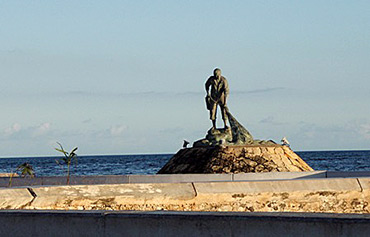 |
|
 |
|
| |
Running nearly two miles along the Bay, Chetumal’s Sculpture Corridor includes seventeen pieces of art including the Fisherman Monument.
|
|
The Alegoria del Mestizaje commemorates the blending of the Maya and Spanish people. When two Spanish soldiers were shipwrecked off the coastline in 1511 and taken slave by the Maya, one of the survivors eventually married the daughter of the local ruler and adapted her way of life. Their offspring became the first Mexican Mestizos, giving rise to Chetumal’s nickname Cradle of the Mestizo (Cuna del Mestizaje).
|
|
Near the town’s main Market, the Museum of Maya Culture (Museo de la Cultura Maya) provides both an insight for neophytes about Maya history, and exhibits to captivate and inform even the most enthusiastic Maya devotee. The three-story Museum replicates the Maya cosmogony of the World Tree: the main floor the world we inhabit, the upper floor the heavens, and the lower floor the Maya underworld, Xibalbá.
| |
Chetumal’s Museum of Maya Culture includes scale models of structures such as the roof comb from Temple I at Tikal as it may have appeared 1500 years ago (left), compared to its current condition (right). A lot of beauty can be erased by 1,200 years of erosion. |
|
Replicas and reproductions include stelae from Copán and murals from Bonampak, and a bevy of artifacts and site models. Interactive exhibits include a Maya Long Count calendar whose interlocking wooden gears demonstrate the correlation between Maya calendars (See The Maya & 2012: Passage to a New Beginning http://www.highonadventure.com/hoa12oct/vicki/maya.htm for more about Maya calendars). And for Spanish-challenged visitors, all exhibits are labeled in English as well as Spanish.
I have barely scratched the surface of known Maya settlements and history in this area. How many more hidden cities and ancient chronicles carved in stone await discovery? When will the Río Bec region and Calakmul Biosphere Reserve give up more of their secrets? Most importantly, how soon can I return? |
|